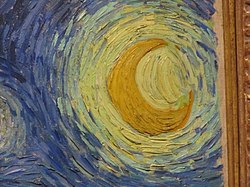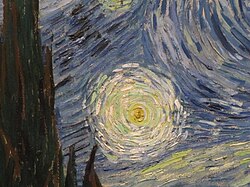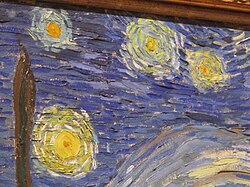2 The Starry Night




2.1 Key Details
- Estimated Value: $750 million - $2 billion USD as of 2025 (theoretical; painting is priceless and will never be sold).
- Dimensions: 73.7 cm × 92.1 cm
- Current Location: Museum of Modern Art, New York
2.2 Overview
“The Starry Night” is an oil painting on canvas by Dutch Post-Impressionist artist Vincent van Gogh, painted in June 1889. Created during his stay at the Saint-Paul-de-Mausole asylum in Saint-Rémy-de-Provence, France, this masterpiece depicts a swirling night sky over a quiet village. The work combines van Gogh’s view from his asylum window with his vivid imagination, resulting in one of the most recognizable and beloved paintings in art history.
2.3 Subject Matter & Iconography
The painting presents a dramatic nocturnal landscape dominated by a turbulent, star-filled sky. A large dark cypress tree rises in the foreground on the left, its flame-like form reaching toward the heavens. Below, a peaceful village nestles in a valley, centered by a church steeple that pierces the night. A crescent moon blazes in the upper right corner, surrounded by radiating stars and nebula-like swirls.
The cypress tree serves as a powerful symbolic element, traditionally representing a bridge between earth and heaven, death and eternal life. The swirling cosmos above reflects van Gogh’s intense emotional and spiritual state, while the serene village below may represent his longing for peace and community. The composition masterfully balances the cosmic drama above with earthly tranquility below, creating a meditation on humanity’s place within the universe.
2.4 Cultural & Art Historical Context
“The Starry Night” stands as a pinnacle achievement of the Post-Impressionist movement, painted during van Gogh’s most productive and emotionally turbulent period. The work represents the culmination of his experiments with night scenes, following earlier works like “Café Terrace at Night” (1888) and “Starry Night Over the Rhône” (1888).
Van Gogh’s technique of thick impasto and dynamic, visible brushstrokes broke new ground in expressing emotion through paint application itself. The work shows influences from Japanese ukiyo-e woodblock prints in its bold composition and flattened perspective, as well as Romantic landscape traditions in its emphasis on sublime natural forces. Created during his Saint-Rémy period, the painting demonstrates how van Gogh transformed personal anguish into universal artistic vision, establishing him as a key figure bridging 19th-century art with the emerging modern movement.